This was published 8 years ago
Turkmenistan travel guide: For travellers searching for exotic and unusual experiences
Michael Gebicki discovers the split personality of Ashgabat, and it's not all black and white.
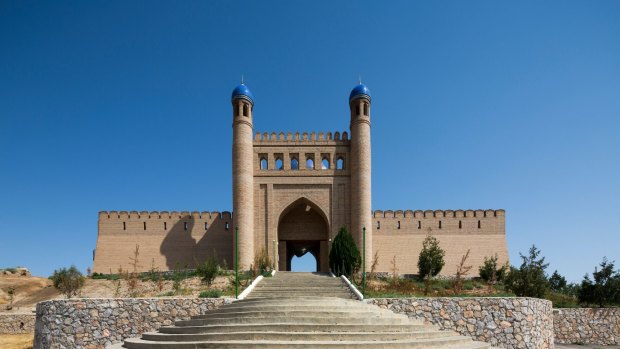
Modern reconstruction of gate of citadel of Mugh Tappa, Istaravshan, Tajikistan. Credit: Alamy
When I part the curtains of room 510 in the Ak Altyn Hotel and look out across the city of Ashgabat, capital of Turkmenistan, spaceships have landed on the hills that creep like caterpillars toward the brown curtain of the Kopet Dagh mountains. On the right, a flame-shaped structure in steel and glass is catching the morning sun while to the left is what appears to be an enormous nut balanced on one of its flat hexagonal edges. The nut is Bagt Kosgi, Happiness Palace, the venue for high-class weddings, while the flame - which bears a striking resemblance to Dubai's Burj Al Arab Hotel – is the Yyldyz Hotel, one of the latest additions to Ashgabat's skyline.
Set on a cresting hill in the distance a gigantic eight-pointed star in blue glass is impaled in the base of a rocket ship with a spiked antenna at the top, Ashkabat's broadcasting centre. Modern Ashgabat – "City of Love" in Persian – calls for a sense of humour, and industrial strength eye protection.
Turkmenbashi Avenue, one of the city's showpieces, is lined with eight storey apartment buildings in gleaming white marble. No balconies since residents might disturb the shining perfection of their apartment block by hanging washing or airing carpets over the balustrades. Ditto for cars, which are parked at the back. There is nothing here to disturb the perfect equilibrium of an absolutist vision, and that includes people. Nobody strolls along these bright white avenues, no children or dogs gambol on their lawns or in their perfectly symmetrical gardens. So dauntingly expensive are these apartments that less than 30 per cent are occupied.
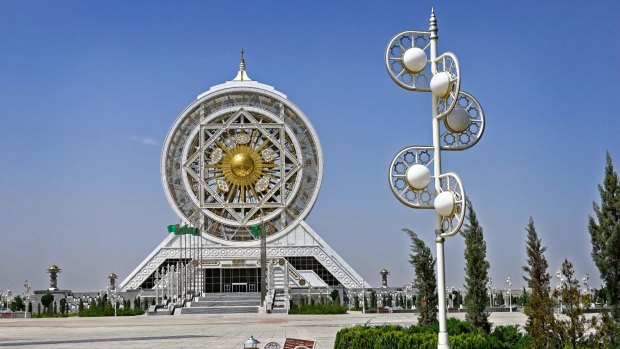
The indoor ferris wheel. Credit: Michael Gebicki
From the viewing platform on the city's Neutrality Arch – reached via a succession of splashing fountains and roundabouts with celebratory sculptures plonked in the middle – I look out across hectares of park, all symmetrically arranged, and all empty at 9 on a Saturday morning. Yet when I descend from the Ak Altyn Hotel, I'm in another city. This is old Ashgabat which has a kind of ramshackle charm, a patina that age brings even to Soviet architecture.
Here the apartment blocks along the main boulevards are two or three storeys only, often in a lemony colour with white window surrounds that give the facades a classical touch. There are big, straggly trees that disrupt the pavements and anarchic parks with weeds and leaking water towers. In the back streets you can paint your house lime or pink or ochre, plant a satellite dish on the roof, hang your washing pretty much where you like and park your car across the pavement.
Ancient mulberry trees, both the black and white variety, smudge the pavement exotically and totally unlike the white city there are people here, lounging around in their gardens bouncing babies on their knees, lumping bread and potatoes and pomegranates home from the Teke Bazaar or sitting under the shade of a trellised grapevine playing backgammon with their pals.
Every citizen of Turkmenistan gets electricity, gas, water and salt free of charge.
If ever there was a city with a split personality it's the capital of Turkmenistan. The dividing line between old and new can be traced to a moment in time, the fragmentation of the Soviet empire. When it all fell apart in the late 1980s, Turkmenistan, the most impoverished of all the Soviet republics, suddenly found itself with a trough of cash on its hands. Turkmenistan has the world's fourth largest gas reserves and substantial oil deposits, and a population of barely five million to spend it on.
Sitting on top of it all was an absolute ruler Saparmurat Niyazov, a fully paid-up nutter whose megalomania stopped just short of Kim Il-sung's. Among his most celebrated notions, Niyazov, who styled himself Turkmenbashi, "Leader of Turkmen", reworked the calendar, renaming January after himself and April after his mother. September became Ruhnama, the name of Niyazov's own book, defined as a spiritual guide for the Turkmen nation, and required reading for high school students and anyone taking the driving test.
The city streets he named after himself or his parents, the rest had numbers. It was Niyazov whose vision of a futuristic city of monumental boulevards, fountains and parks has now been realised in Ashgabat's so-called white city, which he also sprinkled with gold-painted statues of himself, one of which rotated to always face the sun.
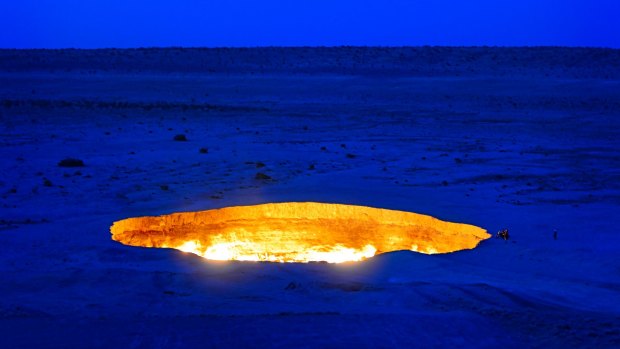
The gas crater in the Karakum Desert.Credit: Michael Gebicki
The architecture sometimes ventures into the hilarious. Ashgabat boasts the world's largest fully enclosed ferris wheel. The Ministry of Education looks like a book, the Bank of Development has a huge gold coin balanced on top like an enormous pancake but best of all is the Ministry of Oil and Mineral Resources, made to resemble a cigarette lighter.
Niyazov's "Golden Reign" involved a cash splash that could be profitably adopted by other leaders looking to quieten dissent. Every citizen of Turkmenistan gets electricity, gas, water and salt free of charge. Until early 2014 each car owner received 120 litres of petrol per month, also free. Now they pay about 40 cents per litre, and complain, but not too loudly since protest is not in your interests.
The Central Asian "Stans" have been slow to open their doors to the wider world – Turkmenistan more than most. But if you're looking for a traditional-minded Central Asian country that has kept the wider world at bay, Turkmenistan is it. Sandwiched between Russia and China and a closed world during the Soviet era, the five Stans of Central Asia are now opening the front door to reveal a new galaxy of wonders for the connoisseur of exotic and unusual experiences. If the "Stans" have learned one thing from their time in the USSR, it's how to deal with dissent. The result is a new world – and the certain satisfaction of seeing it before McDonald's and the mob get there.
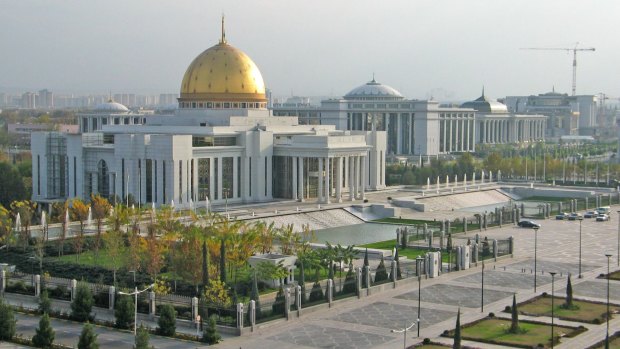
The presidential palace in Ashgabat, capital of Turkmenistan. Credit: Getty Images
For the most part, women wear national costume, a long, brightly coloured dress with an embroidered yoke around the neck and an enormous headscarf if they're married. Personal safety is absolute, underwritten by a pervasive police presence. Tourists are scarce, and treated warily as one might an unpredictable rhino.
Yet for those who come, Turkmenistan has a handful of unique experiences. Set like a lumpy cap over the top of Iran and Afghanistan with the Caspian Sea at its western border, Turkmenistan is a country of nomadic sheep and goat herders. Rainfall is scarce, dust storms are ferocious and frequent. Most of the country is covered by the parched sands of the Karakum Desert. The Amu Darya River, the ancient Oxus and now the border with Uzbekistan, is the only substantial natural watercourse.
Curiously for a country populated by steppe nomads, the Turkmen have a taste for great cities. One of these, , Nisa, lies on the outskirts of Ashgabat, long since ruined and abandoned, the contours of its mud brick fortifications and palaces softened and blurred like a sandcastle that's been licked by waves. According to archaeologists this was the first capital of the Parthians, once a force to be reckoned with in Central Asia, whose cavalry shook the legions of the Roman Empire and sent them packing.
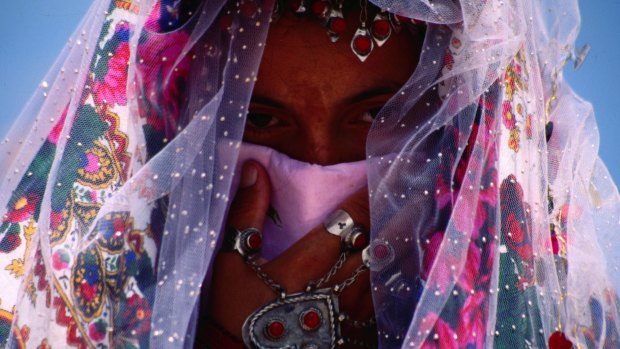
A bride wears traditional Turkmen headwear and jewellery,Credit: Getty Images
The remains of Nisa barely hint at what once existed here yet the National Museum in Ashgabat has a fine collection of Parthian treasures excavated from the site and they're electrifying. While the modern Turkman wears the evidence of the Mongol invasions in their faces, the sculpted Parthian heads in the museum could be Greeks. There are wall frescoes and delicate ivory heads, carnelian necklaces and terracotta capitals with lion's heads. They drank wine from fine ivory horns, often with a gryphon or a centaur at the pointy end, impossible to put down without spilling the contents which suggests a culture with its heart in the right place.
The Parthian Empire fell apart during the third century AD but by that time the first caravans of the Silk Road were inching between China and the bazaars of Baghdad. A line of cities grew up along the plains on the northern side of the Kopet Dagh mountains, which today define the border between Turkmenistan and Iran, the line in the sand between Persian and Turkic worlds.
A hundred kilometres west of Ashgabat, Abiverd was a major Silk Road city between the 9th and 13th centuries. Its walls enclosed an area of 42 hectares, canals supplied its water and the city was known for its ceramics but then along came Tulikhan, youngest son of Genghis, who murdered, enslaved or scattered its population.
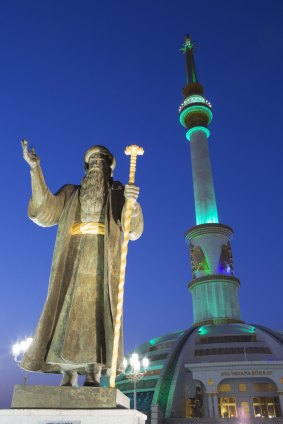
Statue in front of Independence Monument at dusk, Ashgabat, Turkmenistan. Credit: Getty Images
Today the high walls that once guarded the city have been reduced to bumps. Lines of mud-brick walls show where streets once stood, glittering with shards of pottery in jade, turquoise and cerulean. It's everywhere – not just in the ground but embedded in Abiverd's mud-brick walls, a reminder of the destructive whirlwind that the Mongols unleashed upon the civilised world.
Most impressive of all Turkmenistan's Silk Road cities is Merv, 360 kilometres west of Ashgabat. Merv underlines the perils of building in a place where the only construction material is mud. Nothing lasts. But this was once the seat of the powerful Seljuk Empire which cast its shadow to the gates of Constantinople.
Merv was made wealthy by its position, which made it a prize, but a slippery one. The Turkic tribes were never a unified force until well into the 1800s, and the city was successively sacked by the movers and shakers in this part of the world – Genghis Khan, Tamerlane, and countless steppe warlords. They say that Tulikhan killed more than a million when he took the city. Merv eventually threw in its lot with the Russians, falling under the protective umbrella of the czar in the late 1800s.
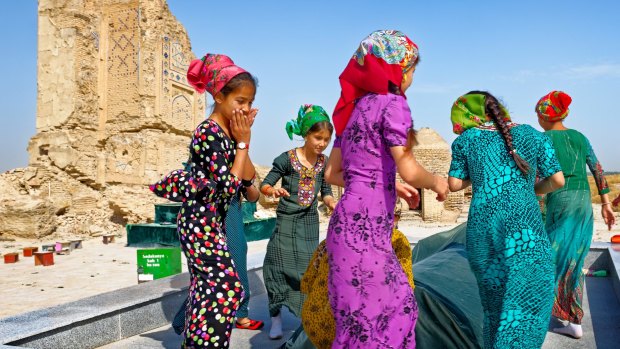
Tomb of an unmarried woman at the 15th-century Seyit Jamal-ad-Din Mosque outside Ashgabat. Young women come here to ask that they will be blessed with babies. The headscarves suggest that these girls are already married.Credit: Michael Gebicki
Today it takes a leaping imagination to reconstruct what once existed here yet Merv was once home to Buddhist and Zoroastrian temples, Christian churches, Jewish synagogues and mosques and a population that made it the largest city in the world eight centuries ago.
One of the wonders of Turkmenistan is a curious mistake. Back in the 1970s Soviet geologists identified a promising oil field in the Karakum Desert about 260 kilometres north of Ashgabat. They set up a drill rig and went to work but what they found was not oil but gas, which hissed to the surface leaving a crater that swallowed the drill rig. They decided the easy way to deal with the poisonous gas was to burn it off, so they tossed in a match, expecting the fire would extinguish itself in a few days. More than four decades later the fire still burns and the crater has become a giant fire pit 90 metres across and 40 deep, filled with a thousand flickering tongues of flame. Up close it gobbles air, creating a vortex of wind around its periphery, roaring like a distant ocean.
You need to camp here overnight to witness the full effect of the crater and it's both beautiful and terrifying, lighting up the night sky with a flare that can be seen from the highway eight kilometres away and justifying its name, "The Door to Hell".
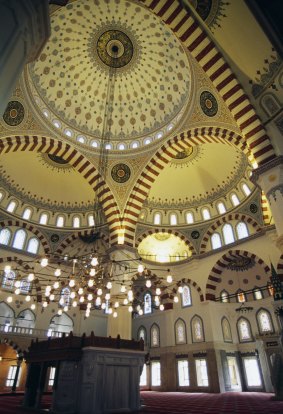
The interior of Ertugrul Gazi mosque in Ashgabat, Turkmenistan.Credit: Getty Images
It's barely daybreak the next morning when I scrunch up a paper napkin and cast it into the hole, expecting it to burst into flames. At first it sinks into the fire cauldron but then it hovers, dancing just above the flames, riding the warm air currents and then it catches an updraft and soars into the morning sky, 10, 20 metres above the top of the crater, swooping low and rising again, playful as a bird. I loose sight of it eventually when it disappears, swallowed up in blue sky on the far side of the crater. Nothing ends quite how you think it's going to, which just about sums up Turkmenistan.
STRANGELANDS: MEET THE STANS
UZBEKISTAN
By far the most popular and tourist-friendly of the Stans, and as intriguing as it was in the time of Tamerlane. Starting point for most journeys is the capital, Tashkent, but the focus of interest is the cities of the ancient Silk Road – Bokhara, Khiva and Samarkand.
KYRGYZSTAN
Dominated by the Tien Shan Mountains which leap from green valleys to peaks where the snow never melts and populated by yurt-dwelling semi-nomadic shepherds who still hunt with golden eagles. Now laying out the welcome mat with visa-free travel.
KAZAKHSTAN
Wrestled from the Central Asian steppe and flushed with newly minted oil and mineral wealth, Astana, the capital, stands on the futuristic frontier of modern architecture. Caviar baths and space tourism at the Baikonur Cosmodrome are among its unlikely attractions, along with the peaks and valleys of the Tien Shan Mountains.
TAJIKISTAN
Wild, raw and unpredictable, the overwhelming fact of this jigsaw-piece country is the Pamir Mountains. Accessed from the city of Khorugh, the Wakhan Valley in the country's south has emerged as the highlight for visitors, with superb walks through green valleys rising to ridgetops with distant views of the Hindu Kush.
TRIP NOTES
MORE INFORMATION
GETTING THERE
The easiest access to Turkmenistan is via the Qantas Emirates partnership to Dubai, from where there are daily flights to Ashgabat. A letter of invitation will allow you to obtain a visa on arrival at the airport in Ashgabat, and the only practical way to obtain this is via a tour operator.
TOURING THERE
Peregrine Adventures' nine-day Turkmenistan Discoverer starts from $2444 per person on a twin-share basis. The itinerary includes Ashgabat, Merv, the Door to Hell and several former Silk Road cities. Ideally you might combine this with one of Peregrine's trips through Uzbekistan or even into Kyrgyzstan and Tajikistan.
The writer was a guest of Peregrine Adventures
FIVE MORE ANCIENT CENTRAL ASIAN CITIES
BUKHARA
More than any other city in the region, Bukhara shows what a medieval Central Asian city would have looked and felt like. Among the highlights are The Ark, the squat, formidable palace-fortress of the emirs and the holy city with the Kalan Mosque and the opposing Mir-I-Arab Medressa, anchored by the giant staff of the Kalan Minaret. There's shopping here too, in the three domed bazaars known collectively as the cuploas and finally Labi-hauz, an open square almost entirely covered by a large pond and surrounded by open-air cafes.
SAMARKAND
Tamerlane's capital, created by the captive armies of craftsmen, architects and masons who were hauled back and set to work to build a city that would sing the praises of Allah. His supreme achievement was the Registan, where three medressas, the schools of Islam, frame a courtyard. Samarkand is also a good place to shop for carpets, still a thriving cottage industry in the cities of the old Silk Road.
KHUJAND
In Tajikistan's northern Fergana Valley, this is one of the oldest cities in Central Asia, with a fort, several impressive mosques and the sprawling Panjshanbe market, which conjures up memories of the time when this was an important caravanserai on the Silk Road. A new addition is the museum dedicated to the Sogdians, a subtle culture that seems as ethereal and desirable as that of Atlantis.
ISTARAVSHAN
In northern Tajikistan, Istaravshan was founded 2500 years ago and the city has a well preserved old town with maze-like streets that thread between courtyard walls. A few ancient caravanserais remain, there's a fabulous bazaar and tourists are rare.
KOKAND
In eastern Uzbekistan at the end of the Fergana Valley, the minarets of Kokand would have been a welcome sight for travellers after crossing the Tien Shan Mountains from Kashgar. The city has a number of mosques and madrassas but nothing much older than the 18th century. The enormous Khan's Palace is the preeminent sight.
Sign up for the Traveller Deals newsletter
Get exclusive travel deals delivered straight to your inbox. Sign up now.